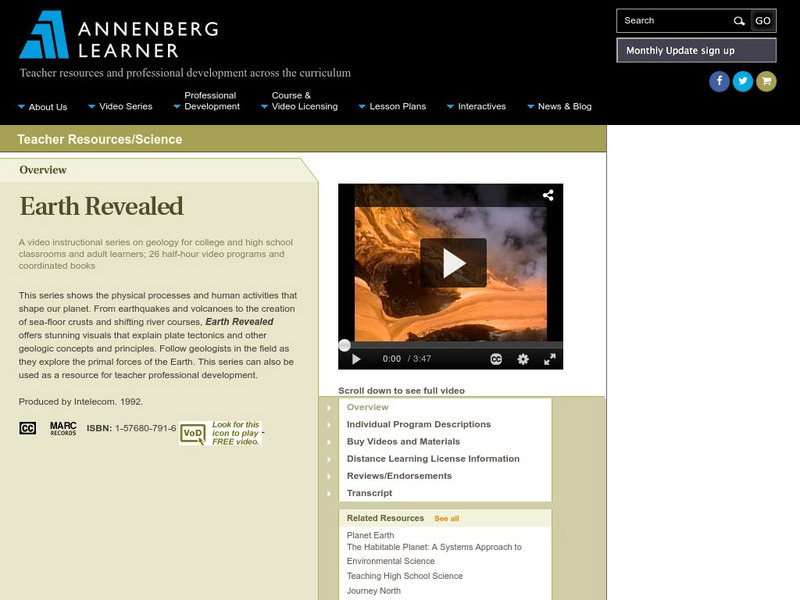Howard Hughes Medical Institute
The Geologic Carbon Cycle
What happens to the CO2 emitted into the air by volcanoes? Scientists discovered it is removed through a series of chemical reactions, as discussed here. Through an animated diagram and chemical reaction equations, viewers learn about...
Be Smart
How Does A Canyon Become Grand?
Ah, the Grand Canyon ... ain't it grand? The narrator of a video from PBS Digital Studios explains, in detail, how the Grand Canyon was formed over millions of years.
Crash Course
Nitrogen and Phosphorus Cycles: Always Recycle! Part 2
We wish you a happy, healthy, and phosphorus school year! A video explains the importance of getting the nutrients that are needed and focuses on the nitrogen and phosphorus cycles. It includes discussions on the importance of...
TED-Ed
Why is Mount Everest so Tall?
Many years ago, when the Indian plate collided into the Eurasian plate, the highest mountain on Earth was formed. But what gives Mount Everest its shape? Watch an informative video to learn what factors make the...
Crash Course Kids
Weathering and Erosion
How does water help shape Earth's landforms? This is the focus of a video that describes how mechanical weathering and chemical weathering help shape Earth's geologic features.
Scholastic
Study Jams! Weathering & Erosion
RJ argues that playing the video game, Super Duo Breaker and Whoosh, is a good way to study for a quiz on weathering and erosion. The game character Mr. Breaker breaks things down and the character Mr. Whoosh carries them away in the...
PBS
Pbs Learning Media: How the Ohio River Was Formed
This video segment adapted from KET's Where the River Bends demonstrates how climate change and glacier movement during the Ice Ages destroyed the old Teays River and created the Ohio River, Kentucky's northern border.
PBS
Pbs Learning Media: Hawaiian Coastal Cliffs
This video segment from Nature explains the geologic forces behind the creation of Hawaii's dramatic shoreline. Can be viewed full screen. [1:54]
Annenberg Foundation
Annenberg Learner: Earth Revealed
To support or supplement a course in earth science or geography, Annenberg Media offers twenty-six Videos on Demand (VoDs). The topics coverd range from why Earth can sustain life, to plate tectonics, to rock types and landscape...
PBS
Pbs Learning Media: Nature Scene: Geology of North Dakota Badlands
NatureScene video in which students learn about the North Dakota Badlands, its geologic history, and how it has been shaped by erosion. [4:07]
Crash Course
Crash Course Kids 17.2: A Change of Scenery
The world changes. It really does! But sometimes it changes so slowly that we don't notice it. Other times it changes REALLY FAST!!! In this episode of Crash Course Kids, Sabrina talks about some of the reasons things can change quickly...
Crash Course
Crash Course Kids 10.2: Weathering and Erosion
In this episode of Crash Course Kids, Sabrina gives us a real world example of how the Hydrosphere and Geosphere affect each other in the form of Weathering and Erosion. Think of Weathering as the force that makes a mess and Erosion as...
PBS
Pbs Learning Media: Nature Scene: Geology of Death Valley
NatureScene introduces students to Death Valley, its features, and how they were shaped by the environment. [4:34]
PBS
Pbs: Over Wyoming: Grades 3 and 4: Land Formation, Fossils, and Erosion
Students will learn about land formation, fossils, and erosion
Next Vista for Learning
Next Vista for Learning: Weathering and Erosion
Understand the process of erosion in this video that briefly explains what happens to sediment over time. [0:48]
PBS
Pbs Teachers: Sand Dunes
Observe the similarities and differences between foredunes, active dunes and scrub dunes while watching kids use the scientific method to find out why some dunes are full of plants and others aren't.











